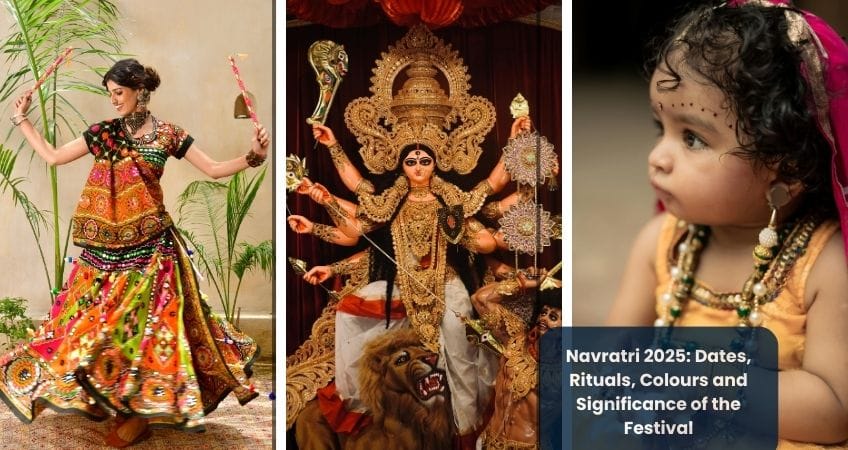Navratri 2025: Dates, Rituals, Colours and Significance of the Festival

Navratri is a popular festival of India having matchless vibrant traditions and festive customs which have significant meaning in relation to spirituality. The devotees gather in the millions for nine nights of festivities to celebrate the feminine energy of the Goddess Durga.
Date of Celebration of Navratri
Navratri is celebrated twice a year - once during the spring season in April (Chaitra Navratri) and second in the autumn season in September/October (Sharad Navratri).
Sharad Navratri is celebrated in 2025 beginning Monday, 22nd September 2025 until concluding Wednesday, 1st October 2025. The festival runs for nine nights and ten days as together devotees will celebrate the event called Vijayadashami or Dussehra on day ten - which celebrates the victory over bad or evil energy.
Celebrations of Navratri begin with Ghatasthapana, or Kalash Sthapana, where devotees place a pot containing water in their home or temple to invoke Goddess Durga- this is the sign of Navratri beginning and the beginning of your spiritual journey.
Nine Goddesses of Navratri 2025
Each day of Navratri is dedicated to a form of Goddess Durga who is referred to as Navadurga. Below are the nine Goddesses revered on each of the nine days in 2025 Navratri:
Days 1 : Shailaputri
Day 2: Brahmacharini
Day 3: Chandraghanta
Day 4: Kushmanda
Day 5: Skandamata
Day 6: Katyayani
Day 7: Kalaratri
Day 8: Mahagauri
Day 9: Siddhidatri
Navratri 2025 Rituals
1. Ghatasthapana (Kalash Sthapana)
Ghatasthapana is the rite of implanting the Kalash pot filled with holy water and topped with mango leaves and a coconut. The Kalash is the call to the Divine Energy of the female, and it is the official beginning of the Navratri festival. The Kalash is worshipped everyday as part of the festival.
2. Fasting and Health Regimen
Many people will oftentimes be fasting during Navratri, as a way of penance and purification. Fasting may be partaking in one meal only, or fasting totally either partaking in fruits only or not partaking in food at all. The practice of fasting is dependent on the devotee's ability to perform this. Fasting is believed to cleanse the body and mind and spiritually elevate oneself to a higher sense of awareness.
3. Daily Puja and Chanting
Each shrine to the Goddess includes Puja where various religious flowers, incense, and fruit and sweets are provided each day. The devotee would recite chants, verses, and stories about Goddess Durga.
4. Kanya Puja (Worship of Young Girls)
Young girls, or the nine forms of the goddess, are worshipped with gifts on the eighth or ninth day for their involvement in the worship. Kanya Puja (girl-worship) honors and respects the feminine energy, which is auspicious.
5. Ayudh Puja (Worship of Tools and Weapons)
In many traditional aspects of the worship on the eighth or ninth day, the worship of tools, weapons, vehicles, and books will take place - establishing respect for the tools of prowess and knowledge which enable facade in life. 6. Cultural CelebrationsNavratri is recognized and celebrated in many parts of India with folk dance forms like Garba, and Dandiya Raas. Festivals focused on music, processions, and elaborate celebrations of Durga Puja have become popular in some regions (especially in West Bengal), and have also become a means of expression for the festival. 7. Vijayadashami (Dussehra) The final day represents the triumph of good exiting evil, and again depending on region, this is illustrated with the burning of effigies of Raavana, Kumbhkaran, and Meghnad.
Navratri 2025 Colours
One of the unique styles of Navratri is to wear colours each day for the week before your specific worship of the goddess, capturing the appropriate energy and attributes of that divine spirit. Merely wearing those colours spiritually connects the pilgrim to the goddess.For 2025, the colour assignment for this Navratri is: (in the worship of Shakti).
Day 1: White
Day 2: Red
Day 3: Royal Blue
Day 4: Yellow
Day 5: Green
Day 6: Grey
Day 7: Orange
Day 8: Peacock Green
Day 9: Pink
These colours will vary slightly depending upon the location and region, but they are a central part of the Navratri celebrations, because the colours bring life to the celebrations, and also some level of correlation with the ceremonial rationale.
Significance of Navratri 2025
Honoring the Divine Feminine: Navratri celebrates goddess Durga, which embodies the concept of Shakti (divine energy).Devotional reverence of the goddess's nine forms represents reverence for divine presence in all forms and aspects of life. Good triumph over Evil: It commemorates the goddess Durga's victory over the demon king, Mahishasura, and symbolizes an eternal struggle of good versus evil. Cultural unity: Navratri commemorates a national unity even amid the differences in culture and rituals, national dances, music, and celebration.
Seasonal and agricultural significance: Navratri is celebrated after the monsoons, and signifies completion of harvest and giving thanks to mother earth for her bountifulness.
Ways to Celebrate Mindfully Navratri 2025
Plan your meals in advance to ensure nutritional balance while fasting. Honor the color of the day, to feel connected to the goddess in small way. Set aside a little time each day for puja, chanting, meditation, etc. Keep things as clean as possible, and, if you would like to, decorate your puja area with lights and/or flowers.
